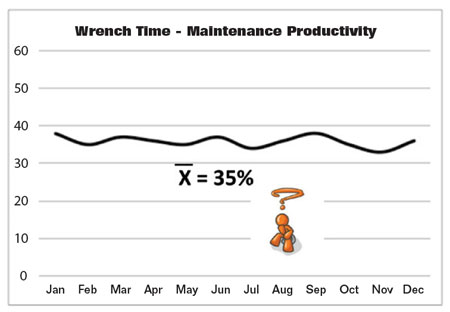Wrench Time – Why the “FEAR” to Measure Maintenance Productivity?
José Wagner Braidotti Jr.
The best results of maintenance practices carried out in enterprises critically depend on the efforts of maintenance staff to ensure their day-to-day actions comply with the schedule of services in order to avoid unwanted failures, correctly diagnose the behavior of active production processes, and ensure quality information recorded in the work orders. This can be measured as maintenance productivity.
Because results depend largely on employees, it is of fundamental importance to know the manner in which these same employees conduct all activities related to the total time they are in the company daily.
On the other hand, there is a great paradigm in business that is represented by the fear of employees to report and record in detail their activities on a day-to-day basis. This fear exists even though these same employees were hired with the understanding that they are responsible for performing the daily tasks that are planned, scheduled and necessary for reliably ensuring the stability of the production process.
The method that enables identification and distribution of activities by employee time is called “maintenance productivity,” which is also known in the international market as “wrench time.”

Applying this method does not, at any time, involve checking the individual behavior of each employee during their daily practices. Their vices in their work routines would reflect in the analysis of the results as a comparison of individual productivity. The wrench time method has as its central focus direct identification of all negative interference that occurs day-to-day so issues can be properly treated. This ensures that a sustainable process is implemented, thereby providing a continuous improvement factor in the use of maintenance employees.
It should be noted that the demand for improvements to be made is not always directly related to maintenance, or maintenance employees participating in this process. Some examples of this are the time waiting for the release of an asset to deliver the service, the time waiting for the material in the warehouse, the time used for daily shifts in the company, the time waiting for the orientation of supervision, etc.
By recognizing the dynamics represented by maintenance activities in the company and understanding the particularities of the various types of tasks performed daily, the better you can understand and know the parameters that lead to loss of productivity. This knowledge will allow you to make the performance of maintenance more assertive and increase the degree of utilization of employees to maintain productivity in the required service so results can be better, both in terms of fulfillment in what is scheduled and in meeting the economic viability of the maintenance department.
Depending on the opportunity for continuous improvement on actions related to processes identified as deviations from performance by direct interference in daily services performed by service technicians, it is possible to identify a dynamic and flexible result, one that is designed through a staggered target in search of the best possible productivity for each analyzed maintenance team.
Click here to read more information about Wrench Time.

José Wagner Braidotti Jr.
José Wagner Braidotti Jr. has more than 28 years of experience in the technical area, working for JWB Engineering and Consultancy as Director, in the SIEMENS Technical Service as Maintenance Engineering Manager, in the ABB Service as Maintenance Engineering Manager of MMC (Maintenance Methodology Center) and in the Indústrias Votorantim – Cement as Senior Mechanical Engineer.
Related Articles

How to Fix the 70/30 Phenomenon

Zen and the Art of Managing Maintenance

Why do maintenance improvement initiatives fail to deliver? (Hedgehog or Fox?)

Why Maintenance Improvement Efforts Fail

TPM and RCM: Whirled Class

Where Do Maintenance Professionals Come From?




